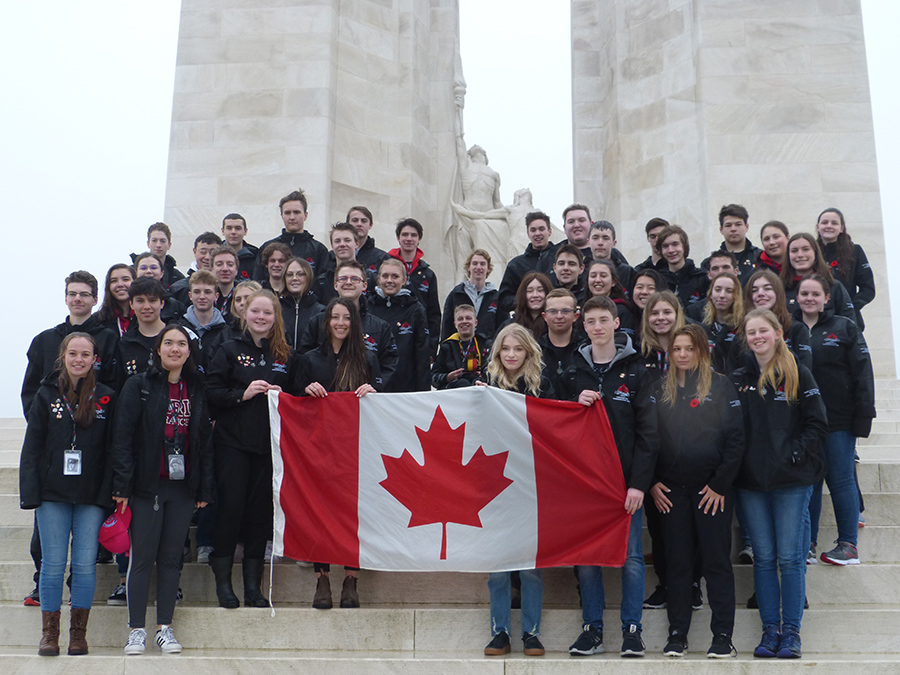
A few days ago, Grade 11 student Caitlin Wager and several of her Uxbridge Secondary School classmates stopped on a bridge in the Netherlands. The overpass was situated amid newly blooming tulips at a popular springtime tourist spot, called Keukenhof. Not surprisingly, the teenagers decided to take some selfies. Suddenly, a Dutch woman approached the Uxbridge girls, and Caitlin thought the woman was going to ask her take a photo for her.
“No,” the Dutch woman said. “I want to take a picture of you.”
“Pardon?” Caitlin asked, not quite understanding.
“All of you,” the woman repeated. “I want a picture of all of you.”
And when the girls asked why, she said, “Because you’re Canadians.”
For the better part of a week, nearly 50 USS students have travelled the battlefields of France, Belgium and the Netherlands, principally to learn where, when and how Canadians served in those three countries during the Great War and the Second World War. Until that moment, Caitlin admitted, the heroism and sacrifice of Canadian soldiers in France in 1916, or in Holland in 1944, was “like reading ancient history.”
Even when guest speakers at school said that people in the Netherlands loved Canadians, Caitlin thought, “Oh, how sweet, that they like us.” But when she walked some of the battlefields and placed flags in cemeteries where thousands of Canadians are buried, it suddenly hit her.
“They appreciate us because of what those soldiers did in the war,” she said. “It suddenly made me really proud to be a Canadian.”

The impact proved equally profound on her father, one of about 20 Uxbridge parents of the students joining the excursion. Rob Wager knew most of his life that his grandfather, Frank Wager, had enlisted in the Canadian Expeditionary Force in 1916 and served right through to the Armistice. But it was never so vivid as last week when he and Caitlin and the others walked through the trenches at Vimy Ridge.
“At 5:30 in the (April 9) morning, 102 years ago, he ran up that hillside,” Rob Wager said. “Next to the bravery and heroism in such horrible conditions, what everybody deals with today feels insignificant.”
It turns out this student trip, led by USS staff and chaperones, has delivered more than just history lessons on location in Europe. For student Graham Baskin and his parents, this “Remembrance Tour” has proven as liberating as war themes their travels revealed.

A year ago, when he learned a prerequisite to go on the trip meant researching the story of his great-great uncle, Alfred Massicotte, Graham knew he’d have to step beyond his comfort zone. He’d have to interview Alfred’s surviving nephew Leonard Perry.
“Graham was terrified,” his mother Colleen said, “because Uncle Len is kind of gruff and never ever talked about the war.”
Still, Graham got Alfred’s story about growing up in Byng Inlet on Georgian Bay, joining up during the Second World War, being streamed him into infantry, serving with the Royal Hamilton Light Infantry, and dying of his wounds while liberating eastern Holland, on March 4, 1945.

What’s more, Graham spoke from his wheelchair next to L/Sgt. Massicotte’s grave this week, drawing on his interview material and first-hand research. In addition to Graham’s commitment to prepare Alfred’s story, the Grade 11 student had to prove he could manage the challenges of his myelin deficiency (impairing his body’s motor controls) while in Europe.
“All last winter, when the walking trail opened, Graham, using his walker, walked the trail,” Colleen Baskin said, “to prove to everybody he was strong enough.”
And should anyone think that Graham might not be capable of touring Dieppe or Vimy, his father Terry said, “Graham said, ‘To hell with that. I’m going on the beach at Dieppe … I’ll crawl there. And I’m going to walk the trench at Vimy.’”
Equally determined to participate in this tour, Karen Croxall, padre for Uxbridge Legion, Branch 170, felt compelled to make a family pilgrimage to the grave of Eric Maxwell Hammond, from her home province of Newfoundland and Labrador.

In a unique tribute to her uncle, Padre Croxall stood beneath a budding tree in Groesbeek Canadian War Cemetery in Holland and read aloud excerpts of some of her uncle’s letters home to St. John’s.
In one note, L/Cpl. Hammond included a list of dos and don’ts he’d accumulated for recruits in the army, including shining one’s buttons every morning and taking a shower at least twice a week. In a particularly poignant note, an obviously homesick soldier looked forward to the prospect of cake sent from home in time for Christmas.
“All we see is plain stuff, not much taste,” Karen read with a tremour in her voice. “Don’t know what Christmas will be like. I wish I was home.”
L/Cpl. Hammond was killed on March 29, 1945, just five weeks before Victory in Europe Day.